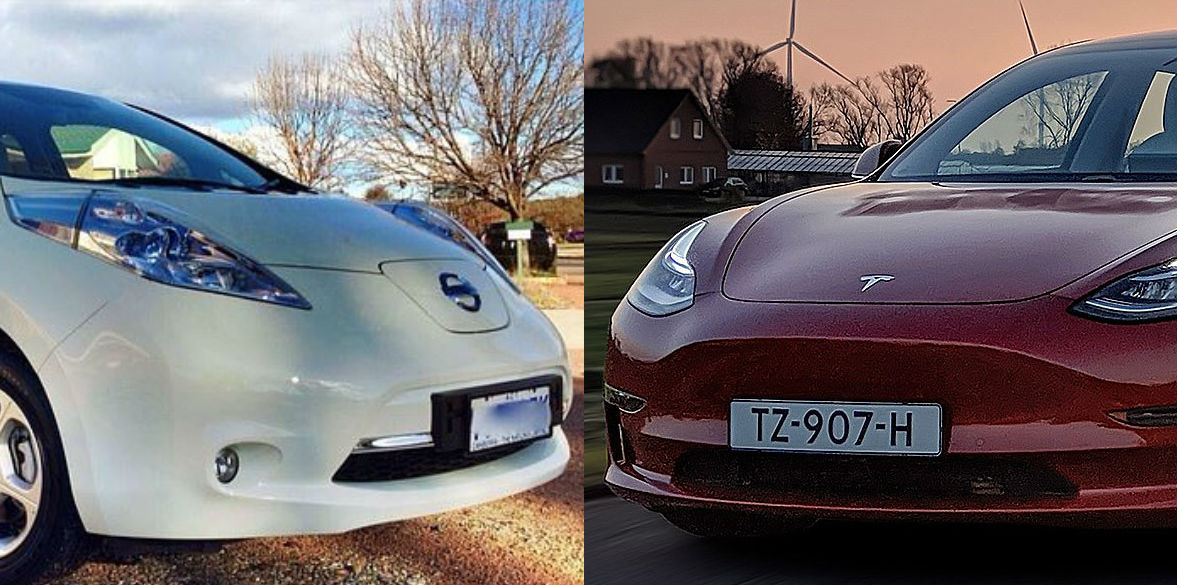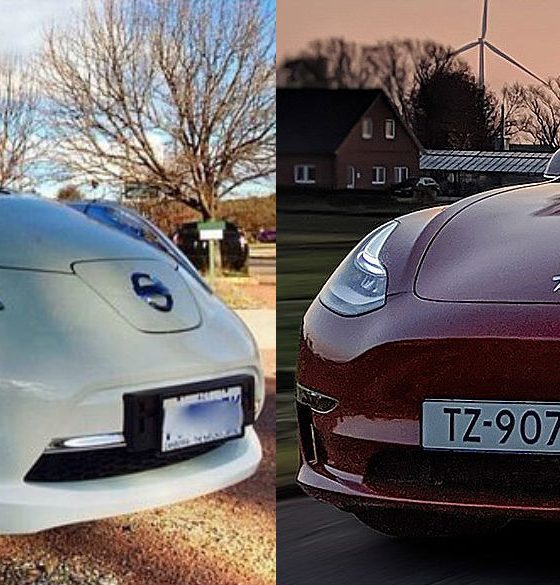

News
Nissan Leaf owner looks to buy Tesla Model 3 after battery invoice nightmare
A longtime Nissan Leaf owner and electric car enthusiast from Australia is looking to purchase a Tesla Model 3 for his next vehicle, following an unpleasant experience surrounding his present EV and a painfully large invoice for a battery replacement.
Canberra engineer Phillip Carlson has been a supporter of electric cars for a long time. This is why in August 2012, he took delivery of a first-generation 24 kWh Nissan Leaf, which he purchased for AU$53,500 (around $35,800). He enjoyed the vehicle and its electric propulsion, though he noticed that he was not getting the range advertised by the Japanese carmaker. Such was expected during winters, but even with regular use, it proved difficult to hit the vehicle’s rated 135 km (84 miles) of range.
Carlson submitted a series of complaints about his vehicle to his dealership over the Leaf’s warranty period, though he was periodically informed that there was nothing wrong with his car. Still, the range issues remained. By 2017, five years after the vehicle was bought, the Leaf was struggling to reach 60 km (37 miles) per charge. The EV enthusiast persisted in his complaints, and earlier this year, it appeared that the dealership finally looked into the issue seriously. “That was the first time they bothered looking at it after I complained so much,” he said in a statement to The Daily Mail Australia.
As it turned out, Carlson’s Leaf actually needed a battery replacement. The Nissan dealership then opted to address the issue, but for a very hefty price. The electric car advocate received an invoice for AU$33,385 (around $22,300) for a full battery replacement for his 7-year-old Leaf. The charge was quite cruel, especially since a 24 kWh first-generation Leaf could be acquired for just about AU$12,000 (around $8,000) in the second-hand Australian auto market.
In a statement to the Australian publication, a Nissan spokesperson stated that it is currently working with the Leaf owner to resolve his vehicle’s issues. As for Carlson, he believes that he should not be charged since his Leaf’s problems were not his fault. The EV enthusiast argued that much of his vehicle’s battery issues were due to Nissan’s design, which lacks ample cooling systems.
Yet, despite his unpleasant experience with his Leaf, Carlson stated that he has no intention of buying a non-electric vehicle. The engineer noted that his next car will definitely be all-electric — it just won’t be a Leaf. Instead, he is looking to purchase a Tesla Model 3, which has more range and has ample cooling for its hefty battery pack. Carlson is also more optimistic about Tesla as the company has extensive experience with electric cars and how they are evaluated and handled.
“Given my time again I’d prefer to hold off buying the Nissan and buy the new Tesla Model 3. Much better range, better support and built by a company that seems to actually care about customers and design their batteries to be (liquid)-cooled. That was the biggest problem with Nissan, even the new model Nissan Leaf still doesn’t water cool the battery,” Carlson said.
Nissan’s treatment of his vehicle’s issues might have been a nightmare, but ultimately, Carlson still considers the small, humble Leaf as a “fantastic” car. “Even as terrible as Nissan has treated me, the Nissan Leaf is still a fantastic car; it’s just that I can’t drive it very far anymore. Just to be clear, I am still a fan of electric vehicles but Nissan has done a terrible thing here,” he said.
H/T Glen Keating.

Elon Musk
Elon Musk’s X will start using a Tesla-like software update strategy
The initiative seems designed to accelerate updates to the social media platform, while maintaining maximum transparency.

Elon Musk’s social media platform X will adopt a Tesla-esque approach to software updates for its algorithm.
The initiative seems designed to accelerate updates to the social media platform, while maintaining maximum transparency.
X’s updates to its updates
As per Musk in a post on X, the social media company will be making a new algorithm to determine what organic and advertising posts are recommended to users. These updates would then be repeated every four weeks.
“We will make the new 𝕏 algorithm, including all code used to determine what organic and advertising posts are recommended to users, open source in 7 days. This will be repeated every 4 weeks, with comprehensive developer notes, to help you understand what changed,” Musk wrote in his post.
The initiative somewhat mirrors Tesla’s over-the-air update model, where vehicle software is regularly refined and pushed to users with detailed release notes. This should allow users to better understand the details of X’s every update and foster a healthy feedback loop for the social media platform.
xAI and X
X, formerly Twitter, has been acquired by Elon Musk’s artificial intelligence startup, xAI last year. Since then, xAI has seen a rapid rise in valuation. Following the company’s the company’s upsized $20 billion Series E funding round, estimates now suggest that xAI is worth tens about $230 to $235 billion. That’s several times larger than Tesla when Elon Musk received his controversial 2018 CEO Performance Award.
As per xAI, the Series E funding round attracted a diverse group of investors, including Valor Equity Partners, Stepstone Group, Fidelity Management & Research Company, Qatar Investment Authority, MGX, and Baron Capital Group, among others. Strategic partners NVIDIA and Cisco Investments also continued support for building the world’s largest GPU clusters.
News
Tesla FSD Supervised wins MotorTrend’s Best Driver Assistance Award
The decision marks a notable reversal for the publication from prior years, with judges citing major real-world improvements that pushed Tesla’s latest FSD software ahead of every competing ADAS system.

Tesla’s Full Self-Driving (Supervised) system has been named the best driver-assistance technology on the market, earning top honors at the 2026 MotorTrend Best Tech Awards.
The decision marks a notable reversal for the publication from prior years, with judges citing major real-world improvements that pushed Tesla’s latest FSD software ahead of every competing ADAS system. And it wasn’t even close.
MotorTrend reverses course
MotorTrend awarded Tesla FSD (Supervised) its 2026 Best Tech Driver Assistance title after extensive testing of the latest v14 software. The publication acknowledged that it had previously criticized earlier versions of FSD for erratic behavior and near-miss incidents, ultimately favoring rivals such as GM’s Super Cruise in earlier evaluations.
According to MotorTrend, the newest iteration of FSD resolved many of those shortcomings. Testers said v14 showed far smoother behavior in complex urban scenarios, including unprotected left turns, traffic circles, emergency vehicles, and dense city streets. While the system still requires constant driver supervision, judges concluded that no other advanced driver-assistance system currently matches its breadth of capability.
Unlike rival systems that rely on combinations of cameras, radar, lidar, and mapped highways, Tesla’s FSD operates using a camera-only approach and is capable of driving on city streets, rural roads, and freeways. MotorTrend stated that pure utility, the ability to handle nearly all road types, ultimately separated FSD from competitors like Ford BlueCruise, GM Super Cruise, and BMW’s Highway Assistant.
High cost and high capability
MotorTrend also addressed FSD’s pricing, which remains significantly higher than rival systems. Tesla currently charges $8,000 for a one-time purchase or $99 per month for a subscription, compared with far lower upfront and subscription costs from other automakers. The publication noted that the premium is justified given FSD’s unmatched scope and continuous software evolution.
Safety remained a central focus of the evaluation. While testers reported collision-free operation over thousands of miles, they noted ongoing concerns around FSD’s configurable driving modes, including options that allow aggressive driving and speeds beyond posted limits. MotorTrend emphasized that, like all Level 2 systems, FSD still depends on a fully attentive human driver at all times.
Despite those caveats, the publication concluded that Tesla’s rapid software progress fundamentally reshaped the competitive landscape. For drivers seeking the most capable hands-on driver-assistance system available today, MotorTrend concluded Tesla FSD (Supervised) now stands alone at the top.
News
Elon Musk’s Grokipedia surges to 5.6M articles, almost 79% of English Wikipedia
The explosive growth marks a major milestone for the AI-powered online encyclopedia, which was launched by Elon Musk’s xAI just months ago.

Elon Musk’s Grokipedia has grown to an impressive 5,615,201 articles as of today, closing in on 79% of the English Wikipedia’s current total of 7,119,376 articles.
The explosive growth marks a major milestone for the AI-powered online encyclopedia, which was launched by Elon Musk’s xAI just months ago. Needless to say, it would only be a matter of time before Grokipedia exceeds English Wikipedia in sheer volume.
Grokipedia’s rapid growth
xAI’s vision for Grokipedia emphasizes neutrality, while Grok’s reasoning capabilities allow for fast drafting and fact-checking. When Elon Musk announced the initiative in late September 2025, he noted that Grokipedia would be an improvement to Wikipedia because it would be designed to avoid bias.
At the time, Musk noted that Grokipedia “is a necessary step towards the xAI goal of understanding the Universe.”
Grokipedia was launched in late October, and while xAI was careful to list it only as Version 0.1 at the time, the online encyclopedia immediately earned praise. Wikipedia co-founder Larry Sanger highlighted the project’s innovative approach, noting how it leverages AI to fill knowledge gaps and enable rapid updates. Netizens also observed how Grokipedia tends to present articles in a more objective manner compared to Wikipedia, which is edited by humans.
Elon Musk’s ambitious plans
With 5,615,201 total articles, Grokipedia has now grown to almost 79% of English Wikipedia’s article base. This is incredibly quick, though Grokipedia remains text-only for now. xAI, for its part, has now updated the online encyclopedia’s iteration to v0.2.
Elon Musk has shared bold ideas for Grokipedia, including sending a record of the entire knowledge base to space as part of xAI’s mission to preserve and expand human understanding. At some point, Musk stated that Grokipedia will be renamed to Encyclopedia Galactica, and it will be sent to the cosmos.
“When Grokipedia is good enough (long way to go), we will change the name to Encyclopedia Galactica. It will be an open source distillation of all knowledge, including audio, images and video. Join xAI to help build the sci-fi version of the Library of Alexandria!” Musk wrote, adding in a later post that “Copies will be etched in stone and sent to the Moon, Mars and beyond. This time, it will not be lost.”








